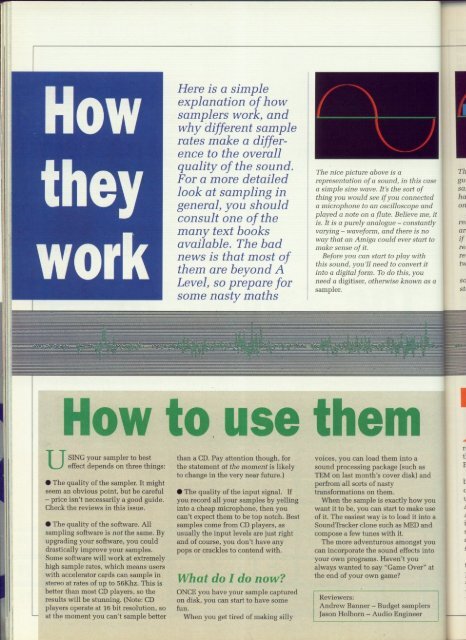Amiga Computing - Commodore Is Awesome
Amiga Computing - Commodore Is Awesome
Amiga Computing - Commodore Is Awesome
Create successful ePaper yourself
Turn your PDF publications into a flip-book with our unique Google optimized e-Paper software.
How<br />
they<br />
work<br />
ow to<br />
U effect depends on three things:<br />
S<br />
• I The quality of the sampler. It might<br />
Nseem<br />
an obvious point, but be careful<br />
- G price isn't necessarily a good guide.<br />
Check<br />
y<br />
the reviews in this issue.<br />
o<br />
•<br />
u<br />
The quality of the software. All<br />
r<br />
sampling software is not the same. By<br />
upgrading your software, you could<br />
s<br />
drastically improve your samples.<br />
a<br />
Some software will work at extremely<br />
m<br />
high sample rates, which means users<br />
p<br />
with accelerator cards can sample in<br />
lstereo<br />
at rates of up to 56Khz. This is<br />
ebetter<br />
than most CD players, so the<br />
r results will be stunning. (Note: CD<br />
tplayers<br />
operate at 16 bit resolution, so<br />
at o the moment you can't sample better<br />
b<br />
11111& e<br />
Here is a simple<br />
explanation of how<br />
samplers work, and<br />
why different sample<br />
rates make a difference<br />
to the overall<br />
quality of the sound.<br />
For a more detailed<br />
look at sampling in<br />
general, you should<br />
consult one of the<br />
many text books<br />
available. The bad<br />
news is that most of<br />
them are beyond A<br />
Level, so prepare for<br />
some nasty maths<br />
•••••••••==-=.<br />
than a CD. Pay attention though, for<br />
the statement at the moment is likely<br />
to change in the very near future.)<br />
• The quality of the input signal. If<br />
you record all your samples by yelling<br />
into a cheap microphone, then you<br />
can't expect them to be top notch. Best<br />
samples come from CD players, as<br />
usually the input levels are just right<br />
and of course, you don't have any<br />
pops or crackles to contend with.<br />
What do I do now?<br />
ONCE you have your sample captured<br />
on disk, you can start to have some<br />
fun.<br />
When you get tired of making silly<br />
The nice picture above is a<br />
representation of a sound, in this case<br />
a simple sine wave. Its the sort of<br />
thing you would see if you connected<br />
a microphone to an oscilloscope and<br />
played a note on a flute. Believe me, it<br />
is. It is a purely analogue - constantly<br />
varying - waveform, and there is no<br />
way that an <strong>Amiga</strong> could ever start to<br />
make sense of it.<br />
Before you can start to play with<br />
this sound, you'll need to convert it<br />
into a digital form. To do this, you<br />
need a digitiser, otherwise known as a<br />
sampler.<br />
se them<br />
voices, you can load them into a<br />
sound processing package (such as<br />
TEM on last month's cover disk) and<br />
perfrom all sorts of nasty<br />
transformations on them.<br />
When the sample is exactly how you<br />
want it to be, you can start to make use<br />
of it. The easiest way is to load it into a<br />
SoundTracker clone such as MED and<br />
compose a few tunes with it.<br />
The more adventurous amongst you<br />
can incorporate the sound effects into<br />
your own programs. Haven't you<br />
always wanted to say "Game Over" at<br />
the end of your own game?<br />
Reviewers:<br />
Andrew Banner - Budget samplers<br />
Jason Holborn - Audio Engineer<br />
Th<br />
gu<br />
so.<br />
ha<br />
on<br />
re!<br />
ar<br />
If<br />
re<br />
re<br />
tiA<br />
1
















